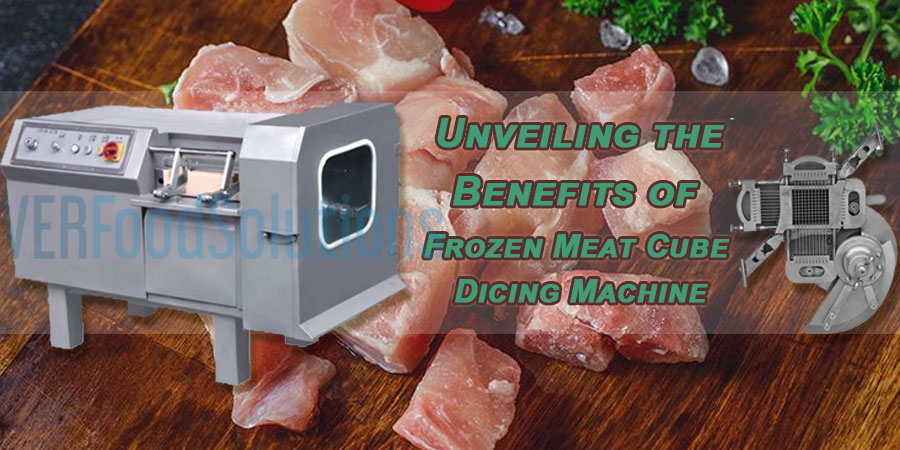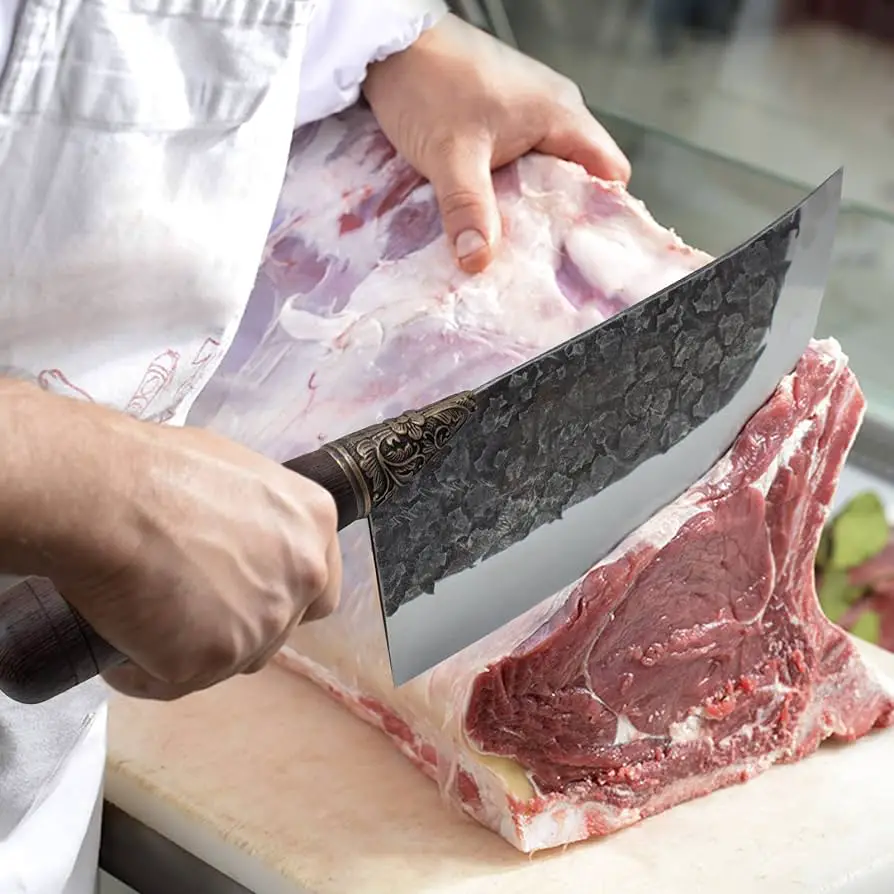A boning knife is necessary when it comes to cutting around bones in meat, as the blade is designed to move and flex easily. A meat cleaver can be used as an alternative to a boning knife, but it is not essential.
A boning knife is specifically designed for separating meat from the bone, making it the ideal tool for deboning poultry, meat, and fish. Its long, thin, and flexible blade with a sharp tip allows for precise cuts and easy removal of raw meat from the bone.

Credit: www.verfoodsolutions.com
The Importance Of A Boning Knife In Meat Preparation
The Importance of a Boning Knife in Meat Preparation
Key role of a boning knife in meat preparation
In the world of culinary arts, precision is paramount. Whether you’re a professional chef or a home cook, the way you prepare meat can make all the difference in the taste and tenderness of your dishes. And when it comes to precise meat preparation, there is one tool that stands above the rest – the boning knife.
Unveiling the power of precise meat preparation
A boning knife is specifically designed to give you the ability to navigate through the intricate anatomy of meat. Its long, thin, and flexible blade allows you to effortlessly separate meat from bones, trim fat, and remove unwanted connective tissue. By using a boning knife, you can achieve clean cuts that preserve the integrity of the meat, resulting in dishes that are not only visually appealing but also tender and flavorful.
The anatomy and features of a boning knife
A boning knife typically has a narrow and pointed blade, which makes it easier to maneuver around bones and joints. The blade is often made of high-quality stainless steel, ensuring durability and resistance to corrosion. Some boning knives also feature a curved or flexible blade, allowing for greater precision and control.
Benefits of using a boning knife in meat preparation:
- Efficiently removes meat from bones.
- Trim fat and unwanted connective tissue.
- Precise and clean cuts for visually appealing dishes.
- Preserve the tenderness and flavor of the meat.
- Maneuverability around bones and joints.
So, if you’re serious about meat preparation and want to take your culinary skills to the next level, investing in a boning knife is a must. Its unique design and features ensure that you can achieve the precision and quality cuts necessary for exceptional dishes. Don’t settle for dull and inadequate knives – equip yourself with a boning knife and elevate your meat preparation game.
Advantages Of Using A Boning Knife
A boning knife is an essential tool in any kitchen, especially for those who enjoy preparing meat dishes. With its unique design and features, a boning knife offers several advantages that make it an indispensable tool for any home cook or professional chef.
Enhanced precision and control
One of the primary advantages of using a boning knife is the enhanced precision and control it provides. The thin and flexible blade of a boning knife allows you to make precise cuts and maneuver around bones with ease. Whether you are removing meat from poultry, fish, or any other type of bone-in meat, a boning knife enables you to navigate the contours of the bone, ensuring that you extract the meat accurately and efficiently.
Effortlessly maneuver around bones
Thanks to its slender and sharp blade, a boning knife allows you to effortlessly maneuver around bones while preparing meat. This makes the task of deboning or filleting much easier and quicker. Unlike other knives that may struggle to glide along the bone, a boning knife’s design allows you to precisely follow the bone’s natural shape, reducing the risk of wastage and ensuring that you maximize the amount of usable meat.
Safely remove meat from bones
Another advantage of using a boning knife is its ability to safely remove meat from bones. The sharp and narrow blade of a boning knife is specifically designed to neatly cut through ligaments, connective tissues, and other tough parts, allowing you to separate the meat from the bone with minimal effort. This results in clean, smooth cuts, minimizing waste and enhancing the presentation of the final dish.
Improved cooking outcomes
By using a boning knife, you can greatly improve the outcomes of your cooking. The precise cuts made possible by a boning knife ensure that each piece of meat is evenly sized and free from unwanted bone fragments. This not only enhances the aesthetic appeal of your dishes but also promotes more even cooking and better flavor distribution. With a boning knife, you can achieve professional-level results in your home cooking.
In conclusion, the advantages of using a boning knife are clear. Its enhanced precision and control, effortless maneuverability around bones, ability to safely remove meat from bones, and improved cooking outcomes make it an essential tool for anyone who regularly prepares meat dishes. Upgrade your kitchen arsenal with a boning knife and experience the difference it can make in your culinary adventures.
Alternative Tools For Meat Preparation
While a boning knife is a valuable tool for meat preparation, there are alternative options that can be used for various tasks. Whether you don’t have a boning knife on hand or are simply looking to explore other tools, understanding the role of different knives and their limitations is important. In this section, we will explore the role of a cleaver in bone hacking, other knife options for cutting through joints, and the limitations and considerations of using alternative tools.
The role of a cleaver in bone hacking
A cleaver is a heavy, rectangular-shaped knife with a thick blade. Its primary purpose is to hack through bone, making it a suitable alternative to a boning knife for separating bones or joints. The weight and shape of a cleaver provide the necessary force to cut through tough bones effectively. However, it’s essential to note that a cleaver may not offer the precision and flexibility that a boning knife provides when it comes to cutting around bones.
Other knife options for cutting through joints
In addition to a cleaver, there are other knife options that can be used for cutting through joints. These include:
- Chef’s knife: A versatile knife with a broad, tapered blade that can be used for various tasks, including cutting through joints. Although not specifically designed for bone hacking, a chef’s knife can handle the task with proper technique and caution.
- Butcher’s knife: Similar to a chef’s knife, a butcher’s knife has a longer and wider blade, making it suitable for slicing through joints and larger cuts of meat. Its sturdy construction allows for more forceful cutting.
Limitations and considerations of using alternative tools
While alternative tools can be used for meat preparation, it’s important to keep in mind their limitations and considerations. Some key points to consider include:
- Precision: Alternative tools may not provide the same level of precision as a boning knife, which is specifically designed for intricate bone work.
- Flexibility: Tools like a cleaver or butcher’s knife may not offer the same level of flexibility as a boning knife, which is essential for maneuvering around bones.
- Safety: When using alternative tools, it’s crucial to exercise extra caution to avoid potential accidents or injuries. Proper technique and grip are necessary for safe and effective use.
How To Choose The Right Boning Knife
Choosing the right boning knife can make a significant difference in your meat preparation process. From the blade material and flexibility to the handle comfort and grip, several factors should be considered. Let’s explore the key considerations to help you make an informed decision.
Blade Material and Flexibility
The blade material and flexibility are crucial factors to consider when choosing a boning knife.
The blade material determines the knife’s durability and sharpness. Stainless steel blades are popular for their corrosion resistance and ease of maintenance. High carbon stainless steel blades are known for their superior edge retention, making them suitable for heavy-duty use.
The flexibility of the blade allows for precise maneuverability around bones and joints. A flexible blade is ideal for deboning poultry and filleting fish. On the other hand, a stiffer blade provides more stability for cutting through tougher meat and connective tissues.
Handle Comfort and Grip
The handle of a boning knife should be comfortable to hold and provide a secure grip to ensure safety and control during use.
Ergonomic handles with a textured or non-slip grip are recommended to prevent slipping accidents. Look for handles made of materials like rubber or thermoplastic elastomer that offer a comfortable and firm hold even when wet.
Consider the size of the handle as well. It should fit comfortably in your hand, allowing for a natural grip and reducing hand fatigue during prolonged use.
Size and Shape Considerations
The size and shape of the boning knife are important factors to consider based on your specific needs.
Blade length typically ranges from 4 to 7 inches. A shorter blade is suitable for smaller cuts of meat, while a longer blade offers more versatility for larger cuts and whole animals.
The shape of the blade can vary between curved and straight. Curved blades work well for tasks that require precision and maneuverability, such as deboning fish and poultry. Straight blades, on the other hand, provide stability and control when cutting through thicker cuts of meat and tough connective tissues.
Budget-Friendly Options
If you’re on a budget, there are several budget-friendly options available that still offer excellent performance.
Brands like Victorinox and Dexter-Russell offer affordable boning knives without compromising on quality. These knives feature stainless steel blades and ergonomic handles, making them a reliable choice for home cooks and professionals alike.
Remember, while it’s essential to consider your budget, investing in a high-quality boning knife can save you money in the long run by ensuring durability and longevity.
Maintaining And Caring For A Boning Knife
Proper maintenance and care are essential for prolonging the lifespan and ensuring optimal performance of your boning knife. By following a few simple steps, you can keep your knife sharp, clean, and safe to use. Here are some tips for maintaining and caring for your boning knife:
Proper cleaning techniques
Keeping your boning knife clean is crucial for preventing the buildup of bacteria and preserving its sharpness. To clean your knife:
- Rinse the blade immediately after each use to remove any food particles or debris.
- Use a mild dish soap and warm water to wash the blade. Scrub gently with a soft sponge or cloth.
- Make sure to remove any stubborn stains by using a gentle abrasive like baking soda or a non-metal scrub brush.
- Dry the blade thoroughly with a clean towel to prevent rusting.
Sharpening and honing
Regular sharpening and honing are essential for maintaining the sharpness and precision of your boning knife. Here’s how you can sharpen and hone your knife:
- Use a sharpening stone or honing rod specifically designed for knives.
- Hold the knife at a 20-degree angle against the stone or rod.
- Using smooth and consistent strokes, slide the blade along the stone/rod from the heel to the tip.
- Repeat this process a few times on both sides of the blade.
- After sharpening, use a honing rod to realign the blade by holding it at a slightly steeper angle and running the blade along the rod a few times on each side.
Storage and safety precautions
Proper storage and safety precautions are vital to prevent accidents and maintain the quality of your boning knife. Consider the following tips:
- Store your boning knife in a knife block, knife roll, or on a magnetic strip to prevent damage to the blade.
- Avoid storing the knife with other utensils or in a cluttered drawer to prevent nicks and scratches.
- Always use a cutting board made of wood or plastic, as using a hard surface like glass or stone can damage the blade.
- Never use the boning knife to pry open cans or bottles, as this can cause the blade to bend or break.
- Always handle the knife with care, gripping it firmly and keeping your fingers away from the blade.
- When transporting the knife, use a knife sheath or blade guard to protect yourself and the blade.
By following these maintenance and care practices, you can ensure that your boning knife stays in excellent condition and continues to provide you with the precision and control needed for deboning and trimming meat.
Frequently Asked Questions
Do You Really Need A Boning Knife?
A boning knife is necessary when deboning poultry, meat, and fish. Its long, thin blade allows for precise maneuvering around bones.
What Can I Use If I Don’T Have A Boning Knife?
If you don’t have a boning knife, you can use a cleaver as a substitute to separate bones or joints.
Why Is Boning Knife Important?
A boning knife is important because it has a flexible blade that can cut around bones, making it easier to remove raw meat from the bone.
Can You Use A Fillet Knife As A Boning Knife?
Yes, a fillet knife can be used as a boning knife as both are designed to separate meat from the bone by cutting through sinew, muscle, fat, and connective tissue.
Why Is A Boning Knife Necessary?
A boning knife is necessary because it allows you to navigate around bones and joints with precision.
Can I Use A Different Knife If I Don’T Have A Boning Knife?
While a boning knife is ideal, you can use a cleaver as an alternative for cutting around bones.
How Is A Boning Knife Different From A Fillet Knife?
A boning knife is designed to separate meat from bones, while a fillet knife is used for delicate cuts of fish.
What Makes A Boning Knife Important?
A boning knife is important because its sharp, thin, and flexible blade allows for easy removal of meat from the bone.
Conclusion
A boning knife is a crucial tool for any home cook or professional chef when it comes to working with meat, poultry, and fish. Its long, thin, and flexible blade allows for precise and delicate cuts, making it easier to navigate around bones and joints.
Unlike other knives, a boning knife is specifically designed to cut through ligaments and connective tissue, making it the ideal choice for deboning and removing meat from the bone with accuracy. While other knives like cleavers or fillet knives can be used as substitutes in certain situations, they lack the versatility and precision that a boning knife offers.
Whether you’re a passionate home cook or a professional chef, a boning knife is a necessary tool in your kitchen arsenal for achieving professional-grade results in deboning and preparing meat for cooking. So, if you want to take your culinary skills to the next level, investing in a high-quality boning knife is definitely worth it.

This is Kristina, a passionate content writer, copywriter, and bookworm. Always dedicated to providing informative and accurate product reviews for enjoyable shopping. In my free time, I love spending time in nature and with animals and doing yoga.

